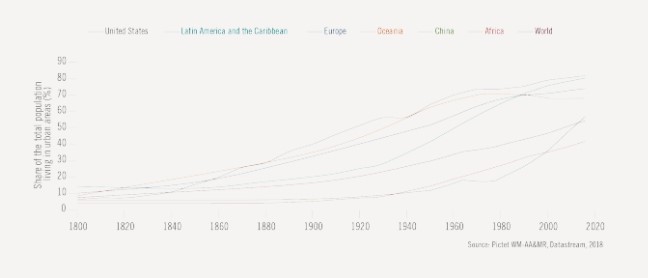It has become increasingly apparent that economic dynamics go beyond changes in capital and labour productivity data in their narrowest sense and extend to include the complex interaction between demographic, economic, political and social trends.
One area where all these trends converge is urbanisation. By 2050, 70% of the world's inhabitants will live in urban centres, compared with 55% today (80% in developed countries and Latin America, see chart). The world's 100 largest cities, where one-fifth of the world population already lives, are set to swell further.
“Investing in sectors and themes that take account of quality of life issues increasingly makes sense and is fast becoming the most effective way to bring about positive change.”
With growing urbanisation will come increased energy requirements: urban centres already account for two-thirds of world energy consumption and 70% of CO2 emissions. Existing trends in this direction could even be speeded up as a result of the coronavirus pandemic. Furthermore, urbanisation is closely related to the rapid development of the digital economy. For all these reasons, urbanisation in all its dimensions has to be taken seriously by investors.
OVER HALF THE WORLD’S POPULATION NOW LIVES IN URBAN AREAS
 The pandemic of 2020-2021 reminds us that protecting health is a central requirement of life. The lack of government preparedness in most countries forced them take emergency measures to stem the crisis, which immediately triggered a deep economic recession. For the first time, policymakers had to make a snap decision to prioritise saving human lives over saving economic growth.
The pandemic of 2020-2021 reminds us that protecting health is a central requirement of life. The lack of government preparedness in most countries forced them take emergency measures to stem the crisis, which immediately triggered a deep economic recession. For the first time, policymakers had to make a snap decision to prioritise saving human lives over saving economic growth.
Preparing for the next pandemic means making health and wellbeing a central focus of policymaking and placing them at the heart of how economies function. Policymakers are realising that economic growth might not continue without attention to quality-of- life issues. This means taking account of the burgeoning need for high-quality services and education that help an increasing urbanised population to adapt to a complex and constantly changing world. Simply, as the global population congregates more and more in urban areas, there is increasing demand for goods and services associated with wellbeing. At the same time, ageing populations will lead to a growing need for medical and personal services.
In the future, governments will be judged less in terms of their contribution to pure economic growth and more on the quality of life they can offer a country’s citizens. For ways of measuring an economy’s progress that look beyond stark GDP figures, one could look at the United Nations Sustainable Development Goals, for example. We can also see a premise of how things might develop in the way that employees already rate companies according to their ability to offer an inspiring and fulfilling work environment. Indeed, high staff ratings are already part of a corporate’s ‘brand’.
The economy of living
We thus see emerging what we call the ‘economy of living’. Supported by policymakers, the economy of living has three main components: environmental protection, social justice and protecting democratic institutional frameworks (where they exist). The idea is to create a virtuous circle in which attention to citizens’ wellbeing drives economic prosperity, stability and resilience.
The ‘economy of living’ concept goes even further to take account of what the changing human population means for complex ecosystems and vice versa. It is only by including analysis of the world’s natural capital that investors can gauge how sustainable current and projected growth trends actually are. Too often, governments—anxious to improve the material wellbeing of their population—can be tempted to exploit that capital for quick economic gain. But wanton exploitation of natural capital is ultimately detrimental to the environment in that country and the people who live there— and therefore hurting the ‘economy of living’.
The economy of living points to decline in some sectors and opportunity in others. It is clear that the losers will include fossil energy, carbon-fuel motor vehicles, the aviation industry, mass transport and mass tourism. Companies which operate in these sectors generally underperformed the markets overall in 2020. Certainly, the pandemic was the over-riding factor, but all these sectors will have to adapt if they are to achieve the same kind of growth as in the past. The winners include alternative energies, education, agriculture and food, as well as health and ecotourism.
In short, for investors, investing in sectors and themes that take account of quality of life issues increasingly makes sense—and is fast becoming the most effective way to bring about positive change and a better future.



